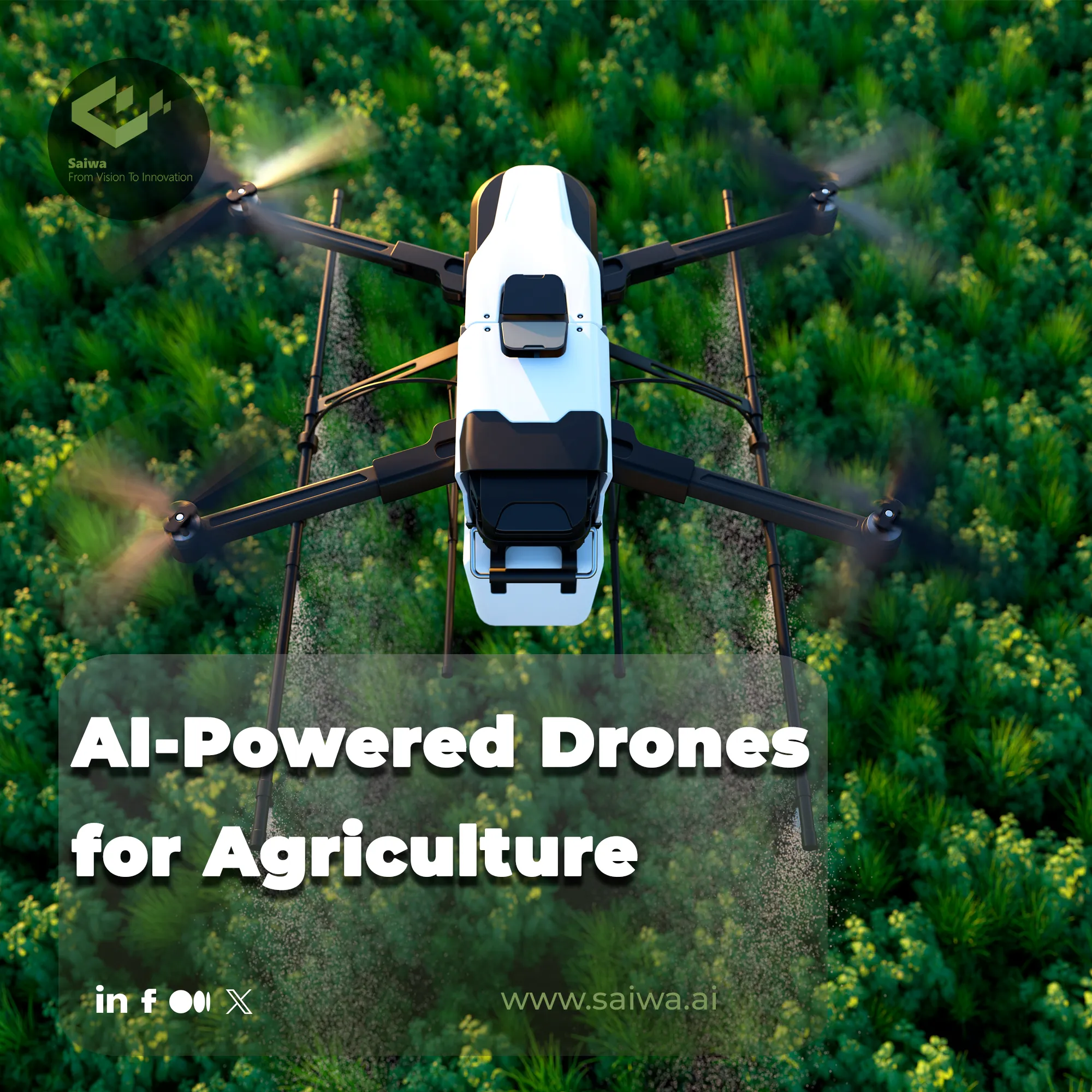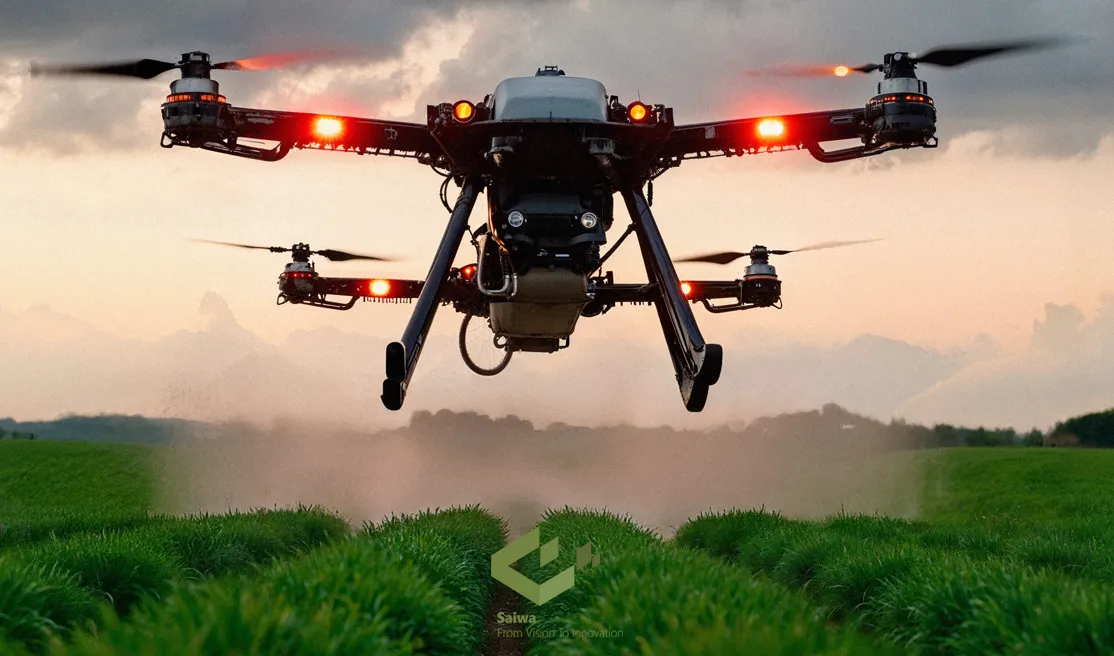AI-Powered Drones for Agriculture: The Future of Smart and Sustainable Farming

Modern agriculture is under pressure. Farmers face rising costs, unpredictable climate conditions, and the need to grow more food with fewer resources. Traditional drones help with aerial imaging, but their reliance on remote servers slows introduces latency.
This is why AI-powered drones represent a major shift. By processing data directly on the device through edge computing, they deliver real-time intelligence exactly when farmers need it.
In this guide, you will discover how AI-powered drones work, the technologies behind them, their practical applications, the benefits they bring to sustainable agriculture, and how platforms like Sairone enable growers to move from reactive decisions to precision-driven smart farming.
What Are AI-Powered Drones in Agriculture?
At their core, AI-powered drones are intelligent aerial systems equipped with onboard "brains." Unlike traditional UAVs that merely capture and transmit raw data for later analysis, these advanced drones process information directly in the field.
This is made possible through edge computing, where AI models run on powerful, integrated computer chips. This capability for immediate analysis transforms the drone from a simple camera in the sky into an active decision-making partner.
In the context of precision and sustainable agriculture, their role is transformative. They enable farmers to apply resources like water, fertilizer, and pesticides only where needed, significantly reducing waste, lowering environmental impact, and boosting overall operational efficiency. This shift from reactive to proactive management marks a new era in farming.
How AI-Powered Drones Work?
The operational workflow of these intelligent machines is a seamless cycle of data collection, analysis, and action. This systematic process empowers farmers with real-time intelligence, moving beyond simple observation to automated intervention. To better understand how AI-Powered Drones for Agriculture function, let's break down their core operational stages:
Data collection via cameras and sensors
The process begins as the drone flies over a field, using advanced cameras and sensors to capture high-resolution imagery. These sensors gather vast amounts of data across different spectrums.
Onboard AI/edge computing for real-time processing
Instead of sending data to the cloud, the drone’s onboard AI processes it instantly. This edge computing capability allows for immediate analysis of crop conditions right in the field.
Decision-making and automated spraying
Based on the real-time analysis, the drone makes immediate decisions. For instance, it can identify a patch of weeds and trigger automated, precision spraying systems.
Continuous learning and feedback loops
The AI models continuously learn from the data they collect. This feedback loop improves the accuracy of detection and decision-making over time, adapting to changing conditions.
Cloud synchronization and long-term analysis
After the mission, data is synced to the cloud. Here, it can be analyzed for long-term trends, helping farmers refine their strategies for future growing seasons.
Core Technologies Behind AI Drones in Precision Agriculture
The remarkable capabilities of these drones are not born from a single innovation but from the powerful synergy of several cutting-edge technologies working in concert. Each component plays a vital role in creating a system that is intelligent, autonomous, and highly effective. Here are the core technologies that form the backbone of modern agricultural drones.
Computer Vision and Deep Learning: These are the "eyes" and "brain" of the drone. Algorithms analyze images to perform tasks like Weed detection and disease identification.
Edge Computing and Onboard AI Chips: These powerful processors enable real-time data analysis directly on the drone, eliminating latency and allowing for immediate action.
Multispectral & Hyperspectral Imaging: These sensors capture light from frequencies beyond human sight, revealing hidden indicators of plant health, water stress, and nutrient deficiencies.
GPS, LiDAR, and Navigation Systems: High-precision GPS and LiDAR ensure accurate flight paths and create detailed 3D maps of the terrain for precise interventions.
AI Flight Control Systems: Advanced AI algorithms manage the drone’s flight, enabling fully autonomous missions, obstacle avoidance, and stable data capture even in challenging conditions.
IoT and Cloud Connectivity: Drones often work within a larger ecosystem of ground-based IoT sensors and sync their findings with cloud platforms for comprehensive analysis.
Applications of AI-Powered Drones in Sustainable Agriculture
The integration of these technologies unlocks a wide array of practical applications that directly address the daily challenges farmers face. By transforming data into targeted actions, these drones drive both productivity and sustainability on the farm.
Let's explore some of the most impactful applications of AI-Powered Drones for Agriculture today:
Weed and pest detection: Drones can identify invasive species and pests with high accuracy, enabling targeted treatment that reduces herbicide use.
Crop Health Monitoring: Through multispectral imagery, drones can monitor crop health, detecting stress from disease or nutrient deficiencies before they are visible.
Precision spraying: Automated systems allow drones to apply precise amounts of fertilizer or pesticide only to the affected areas, minimizing chemical runoff.
Soil and irrigation analysis: Drones equipped with thermal sensors can analyze soil moisture and temperature to optimize irrigation schedules and conserve water.
Yield forecasting and resource optimization: By analyzing crop density and health, these drones can provide accurate Crop yield estimation, helping farmers plan harvesting and logistics.

Benefits of AI-Powered Drones in Agriculture
The value of intelligent drones extends far beyond convenience. This technology delivers measurable gains in efficiency, profitability, and environmental stewardship. Below are the key benefits that AI-Powered Drones for Agriculture deliver to growers:
Real-time decision-making: Onboard processing allows farmers to identify and address issues immediately, preventing small problems from becoming costly ones.
Resource and cost efficiency: Precision application of water, fertilizers, and pesticides reduces input costs and maximizes their effectiveness.
Lower environmental impact: Targeted treatments minimize chemical usage, protecting soil health and nearby water sources from contamination.
Labor optimization: Automating tasks like field scouting and spraying frees up valuable human resources for other critical farm operations.
Scalable for different farm sizes: This technology is adaptable and can provide a strong return on investment for both small family farms and large agricultural enterprises.
Challenges and Considerations
Despite its immense potential, this technology faces practical hurdles. Addressing these logistical and operational challenges is key to its successful integration and widespread adoption:
Hardware and deployment costs: The initial investment for advanced drones and sensors can be substantial, posing a barrier for smaller farms.
Data quality and model training: AI models require high-quality, diverse data for training to ensure they perform accurately across different conditions.
Regulation and airspace restrictions: Navigating the complex web of aviation regulations can be challenging and may limit how and where drones can be operated.
Battery and payload limitations: Limited flight times and payload capacities can restrict the area a drone can cover in a single mission.
Farmer adoption and digital literacy: Effectively using this technology requires new skills, and a gap in digital literacy can slow down its adoption.

The role of Sairone in AI-powered drones in agriculture
At Saiwa, we designed Sairone to solve these challenges directly. Our powerful platform processes high-resolution drone imagery. It transforms this raw data into clear, actionable insights.
Sairone automates crucial tasks like Plant Health Monitoring, pest and Weed detection, and even supports AI in wildlife conservation. We provide precise intelligence that eliminates guesswork and reduces manual labor, empowering you to manage your land more effectively and sustainably. It's easy to take advantage of these benefits, too.

Final Thoughts
AI-powered drones are reshaping agriculture by turning raw aerial data into immediate, meaningful action. They help growers detect problems early, apply resources with precision, and manage land more sustainably. As farms become smarter and more connected, these autonomous systems will play an essential role in improving yields while reducing environmental strain.
From my experience working with AI-driven field technologies, the real power of these drones lies in their ability to give farmers clarity in moments that once relied on guesswork. This shift toward real-time intelligence is more than an upgrade; it is a fundamental evolution in how we cultivate and protect our crops.
Note: Some visuals on this blog post were generated using AI tools.
